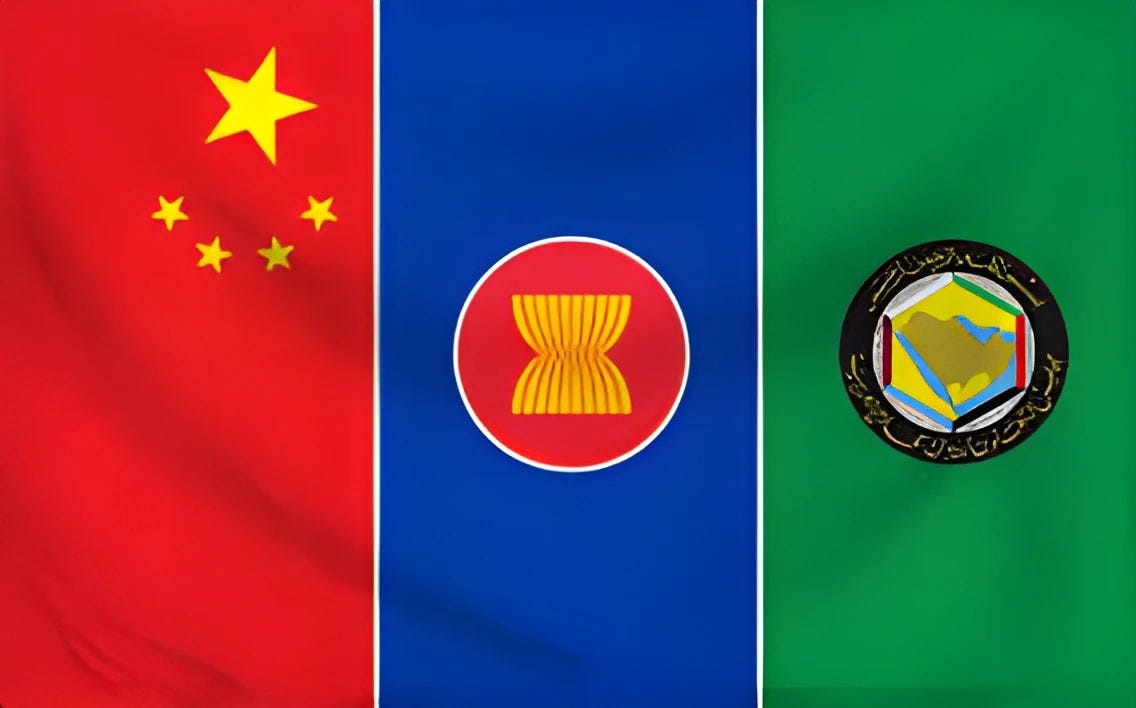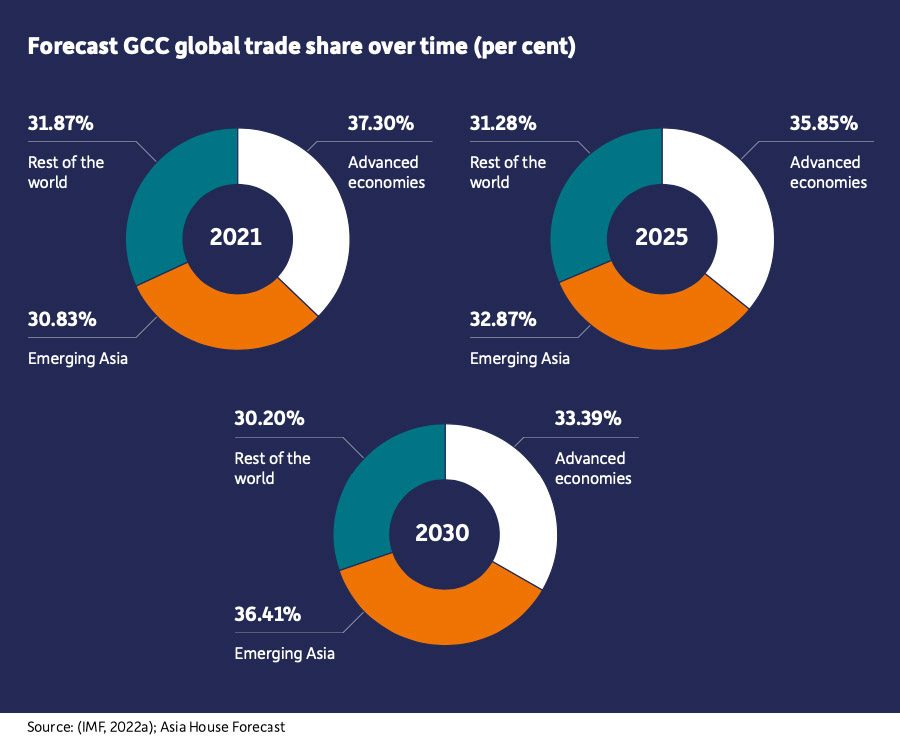A New Axis: ASEAN-GCC-China Cooperation Signals Shifting Global Economic Landscape
Kuala Lumpur Summit: ASEAN, China, GCC deepen "Golden Triangle" ties, countering U.S. tariffs & boosting BRICS partner belt links.
In mid-May 2025, U.S. President Donald J. Trump embarked on his first tour of the Middle East since the start of his second presidential term, visiting Saudi Arabia, Qatar, and the UAE. The trip aimed to secure significant economic deals and formulate a new approach to relations with Middle Eastern powers, resulting in an "investment basket" totaling over $2 trillion, primarily from Qatar. Deals included large aircraft orders for Boeing and substantial arms sales to the UAE and Saudi Arabia.
While Trump sought to position the Gulf monarchies as key economic partners and a "counterweight" to traditional allies like Israel, emphasizing economic ambition and political maneuvering, this visit occurs at a time when these nations, alongside those in Southeast Asia, are increasingly strengthening ties with Asian economic powerhouses.
The upcoming ASEAN-GCC Summit and the inaugural ASEAN-China-GCC Summit in Kuala Lumpur highlight this significant pivot towards fostering a central axis in the world economy spanning East and West Asia.
This burgeoning relationship, which has been deepening since the 1990s, represents enormous complementarities between the regions. It comes amid heightened uncertainty in the world economy and severe trade disruptions caused, in part, by recent U.S. tariff policies. The International Monetary Fund (IMF) downgraded its global growth forecast for 2025, partly citing a series of new tariff measures by the United States and countermeasures by trading partners. ASEAN economic ministers have stated that the unprecedented imposition of tariffs by the U.S. will disrupt regional and global trade and investment flows and supply chains, affecting businesses and consumers worldwide. U.S. tariffs are also endangering $22 billion worth of non-oil exports from GCC economies, according to a UN agency brief.
Against this backdrop, cooperation among ASEAN, China, and GCC countries is expected to inject stability into the world economy and unlock immense potential. Experts have termed this trilateral cooperation platform a "Golden Triangle" of resources, manufacturing, and consumers. These complementary economies aim to ride out trade disruptions and continue powering the global economy.
The economic strengths of each region underpin this powerful synergy:
ASEAN, a bloc of 10 Southeast Asian nations, is the fifth-largest economy globally. With a large, youthful population, abundant natural resources, and a skilled labor force, ASEAN is a major engine powering the global supply chain and industrial development. Countries like Indonesia, Malaysia, Thailand, and Vietnam are experiencing rapid economic growth.
The GCC economies, including Saudi Arabia, UAE, Qatar, Kuwait, Bahrain, and Oman, are expected to see their economic growth rate double from 2.1 percent in 2024 to 4.2 percent in 2025. Their economic resilience is supported by strategic investments, diversification, and robust expansion in the non-oil sector, as the Middle East shifts towards becoming a global green energy hub. Saudi Arabia, Qatar, and the UAE already hold substantial investments in Southeast Asia in sectors like energy, infrastructure, and technology, such as Saudi Aramco's $7 billion investment in Malaysia's Pengerang complex and the UAE's $10 billion green energy commitment in Indonesia.
China is described as an anchor for ASEAN-GCC cooperation, having had a transformative effect on both ASEAN and the wider Middle East through initiatives like the Belt and Road Initiative. China possesses a vast consumer market and a complete industrial system, making it a natural partner for the resource-rich, diversifying GCC economies. Beyond infrastructure and trade, China is increasingly engaged in technology sharing, shared industrialization, tourism, cultural exchange, and people-to-people relationships.
The upcoming ASEAN-GCC-China Summit and the 2nd ASEAN-GCC Summit, hosted by Malaysia in Kuala Lumpur on May 27-28, 2025, alongside the 46th ASEAN Summit, are expected to deepen practical cooperation across various fields. Areas of focus include trade, investment, supply chain, clean and renewable energy, digital economy, electric vehicles, financial markets, and infrastructure development. Negotiations for a free trade agreement (FTA) between Malaysia and the GCC countries are expected to begin on the sidelines of the summit, signifying concrete steps towards closer economic integration.
This push for deeper cooperation also intersects with the evolving landscape of international alliances, notably the BRICS expansion. China, Indonesia, and the UAE are core members of BRICS. Furthermore, at the BRICS Summit in Kazan in October 2024, Malaysia, Thailand, and Vietnam were among 13 countries invited to join the BRICS "partner belt". This new category allows countries to collaborate more closely with BRICS members without full membership, supporting a polycentric, multi-nodal world order that moves away from a single power structure. For ASEAN countries, the BRICS partner belt offers a platform to amplify their voices globally and diversify beyond traditional alliances. China, ASEAN, and GCC members, as part of the Global South, can jointly catalyze more cooperation across other Global South countries, aspiring to protect global trade on which their development depends.
Cooperation among these regions has seen fruitful results recently. The first ASEAN-GCC summit was held in Riyadh in October 2023, outlining measures and activities in security, trade, investment, cultural exchanges, and tourism. The first China-GCC summit in December 2022 saw China pledging to prioritize cooperation in energy, finance, investment, innovation, technology, aerospace, and language/cultural fields. Meanwhile, China and ASEAN have fully completed negotiations on the Version 3.0 China-ASEAN Free Trade Area (CAFTA) and aim to sign the upgrade protocol by the end of the year, building on significant economic ties bolstered by shared participation in regional production networks.
The upcoming summits are poised to establish an important mechanism for trilateral cooperation, allowing the three sides to synergize their economic and industrial policies and upgrade cooperation in fields like clean energy and the digital economy. While the U.S. continues to pursue deals in the Middle East, the focus of Gulf and Southeast Asian nations on building stronger, diversified partnerships with major Asian economies like China, often within broader frameworks like BRICS and South-South cooperation, highlights a significant and ongoing shift in the global economic landscape.







Walt King,
I, too, think this is good news. Had the same take on GCC. Knew all but that one. Went back in the article thinking I had missed it.
Great article, and I really appreciate the graphics! The doubling of economic growth is huge, and can allow for reinvestment into infrastructure and other projects. Currencies are like electricity, they flow more to places and spaces that have less resistance.
Do you think BRICS can fold in ASEAN/GCC into partner members, or do you think that ASEAN and GCC will remain independent?